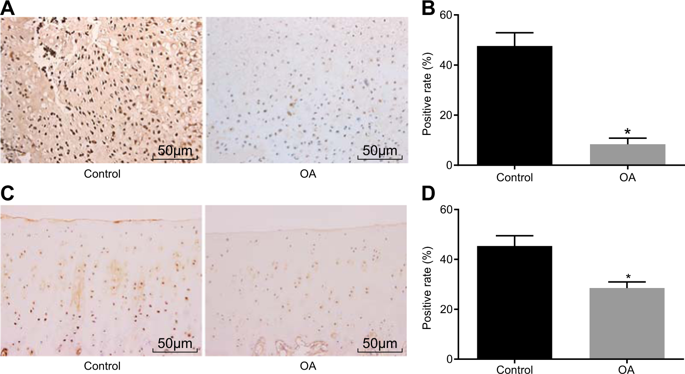当前位置:
X-MOL 学术
›
Gene Ther.
›
论文详情
Our official English website, www.x-mol.net, welcomes your
feedback! (Note: you will need to create a separate account there.)
Inhibition of microRNA-495 suppresses chondrocyte apoptosis through activation of the NF-κB signaling pathway by regulating CCL4 in osteoarthritis.
Gene Therapy ( IF 4.6 ) Pub Date : 2019-04-02 , DOI: 10.1038/s41434-019-0068-5 Da-Wei Yang 1 , Gui-Bin Qian 1 , Ming-Jiu Jiang 1 , Peng Wang 1 , Kun-Zheng Wang 2
Gene Therapy ( IF 4.6 ) Pub Date : 2019-04-02 , DOI: 10.1038/s41434-019-0068-5 Da-Wei Yang 1 , Gui-Bin Qian 1 , Ming-Jiu Jiang 1 , Peng Wang 1 , Kun-Zheng Wang 2
Affiliation

|
As a common form of arthritis, osteoarthritis (OA) represents a degenerative disease, characterized by articular cartilage damage and synovium inflammation. Recently, the role of various microRNAs (miRs) and their specific expression in OA has been highlighted. Therefore, the aim of the current study was to elucidate the role by which miR-495 and chemokine ligand 4 (CCL4) influence the development and progression of OA. OA mice models were established, after which the CCL4 and collagen levels as well as cell apoptosis were determined in cartilage tissue of OA mice. The chondrocytes of the OA mice models were subsequently treated with a series of miR-495 mimic, inhibitor, and siRNA against CCL4. Afterwards, miR-495 expressions as well as the levels of CCL4, p50, p65, and IkBa and the extent of IkBa phosphorylation in addition to the luciferase activity of NF-kB were measured accordingly. Finally, cell apoptosis and cell cycle distribution were detected. miR-495 was highly expressed while NF-κB, CCL4, and collagen II were poorly expressed. Cell apoptosis was elevated in the cartilage tissue of the OA mice. CCL4 was a potential target gene of miR-495. Downregulation of miR-495 led to accelerated chondrocyte proliferation accompanied by diminished cell apoptosis among the OA mice. Taken together, the results of the current study demonstrated that inhibition of miR-495 suppressed chondrocyte apoptosis and promoted its proliferation through activation of the NF-κB signaling pathway by up-regulation of CCL4 in OA.
中文翻译:

在骨关节炎中,抑制 microRNA-495 可通过调节 CCL4 激活 NF-κB 信号通路来抑制软骨细胞凋亡。
作为关节炎的一种常见形式,骨关节炎(OA)代表一种退行性疾病,其特征是关节软骨损伤和滑膜炎症。最近,各种 microRNA (miR) 及其在 OA 中的特异性表达的作用已被强调。因此,本研究的目的是阐明miR-495和趋化因子配体4(CCL4)影响OA发生和进展的作用。建立OA小鼠模型,测定OA小鼠软骨组织中CCL4、胶原水平以及细胞凋亡情况。随后用一系列 miR-495 模拟物、抑制剂和针对 CCL4 的 siRNA 处理 OA 小鼠模型的软骨细胞。然后,相应测量 miR-495 表达以及 CCL4、p50、p65 和 IkBa 的水平以及 IkBa 磷酸化程度以及 NF-kB 的荧光素酶活性。最后检测细胞凋亡和细胞周期分布。 miR-495 高表达,而 NF-κB、CCL4 和 II 型胶原蛋白低表达。 OA 小鼠软骨组织中的细胞凋亡升高。 CCL4是miR-495的潜在靶基因。 miR-495 的下调导致 OA 小鼠软骨细胞增殖加速,同时细胞凋亡减少。综上所述,目前的研究结果表明,在 OA 中,抑制 miR-495 可抑制软骨细胞凋亡,并通过上调 CCL4 激活 NF-κB 信号通路来促进其增殖。
更新日期:2019-11-18
中文翻译:

在骨关节炎中,抑制 microRNA-495 可通过调节 CCL4 激活 NF-κB 信号通路来抑制软骨细胞凋亡。
作为关节炎的一种常见形式,骨关节炎(OA)代表一种退行性疾病,其特征是关节软骨损伤和滑膜炎症。最近,各种 microRNA (miR) 及其在 OA 中的特异性表达的作用已被强调。因此,本研究的目的是阐明miR-495和趋化因子配体4(CCL4)影响OA发生和进展的作用。建立OA小鼠模型,测定OA小鼠软骨组织中CCL4、胶原水平以及细胞凋亡情况。随后用一系列 miR-495 模拟物、抑制剂和针对 CCL4 的 siRNA 处理 OA 小鼠模型的软骨细胞。然后,相应测量 miR-495 表达以及 CCL4、p50、p65 和 IkBa 的水平以及 IkBa 磷酸化程度以及 NF-kB 的荧光素酶活性。最后检测细胞凋亡和细胞周期分布。 miR-495 高表达,而 NF-κB、CCL4 和 II 型胶原蛋白低表达。 OA 小鼠软骨组织中的细胞凋亡升高。 CCL4是miR-495的潜在靶基因。 miR-495 的下调导致 OA 小鼠软骨细胞增殖加速,同时细胞凋亡减少。综上所述,目前的研究结果表明,在 OA 中,抑制 miR-495 可抑制软骨细胞凋亡,并通过上调 CCL4 激活 NF-κB 信号通路来促进其增殖。











































 京公网安备 11010802027423号
京公网安备 11010802027423号